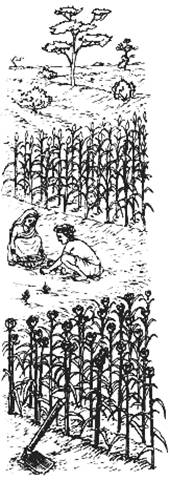/topics/irrigation
Irrigation
Pitcher irrigation - A method that uses round earthen containers for growing saplings
Posted on 15 Sep, 2009 11:46 AM It is similar to drip irrigation, but less expensive to install. The pitchers are the round earthen containers used in rural areas for water storage, ranging from 10 to 20 liters in capacity. This kind of irrigation is ideal for spreading plants such as gourd, pumpkin, and melon because few pitchers are needed per unit area. It is also very good irrigation for saplings, promoting deep root growth.
It is similar to drip irrigation, but less expensive to install. The pitchers are the round earthen containers used in rural areas for water storage, ranging from 10 to 20 liters in capacity. This kind of irrigation is ideal for spreading plants such as gourd, pumpkin, and melon because few pitchers are needed per unit area. It is also very good irrigation for saplings, promoting deep root growth.
Agronomic measures in dryland agriculture: An overview
Posted on 15 Sep, 2009 10:39 AM
Soil and water conservation measures consist of agronomical and mechanical methods. Agronomic methods are supported with mechanical measures where land slope exceeds permissible limits and runoff gains erosive velocities.
The following boxes explain the nature of agronomic measures which are essential in inter-bunded or terraced areas. These practices enhance the utility value of all kinds of mechanical structures.
How to catch rainwater where it falls - An intoduction
Posted on 14 Sep, 2009 04:39 PMPerhaps you are a farmer and you want to practice good water and soil management for your crops and trees, or you own some land and you want to manage it carefully to recharge the groundwater. You may be focusing on what you can do with your own land, or wondering what your community can do, or you may even be thinking at the watershed level.
Integrated approaches for sustainable development in water resources sector
Posted on 04 Sep, 2009 12:11 PMThe Indian Institute of Technology, Madras, Technology for Sustainable Development and the Ecole Polytechnique Federale de Lausanne EPFL have produced a report titled Integrated Approaches for Sustainable Development in Water Resources Sector.
Guidelines on various components of National Project on Organic Farming: Department of Agriculture & Cooperation
Posted on 02 Sep, 2009 11:22 AMMore crop and income per drop of water - Report by the advisory council on artificial recharge of groundwater (MoWR) (2006)
Posted on 02 Sep, 2009 11:03 AMThis report by the Advisory Council on Artificial Recharge of Ground Water, the Ministry of Water Resources, Government of India is divided into the following sections:
Minor irrigation for land owned by dalits and adivasis - A presentation to National Advisory Council (2007)
Posted on 02 Sep, 2009 10:52 AMThis is a presentation is the output of the review and discussion done by the National Advisory Council (NAC) on the provision of the National Common Minimum Programme of the current UPA government. The mandate was managed by the Ministry of Water Resources (MoWR). The presentation looked at the scope and implementation aspects of minor irrigation schemes, potential for supporting schemes of Union Ministries for minor irrigation, existing schemes of MoWR, incentives for tribal and dalit communities, efforts for convergence, issues and points for consideration going forward.
System of Rice Intensification
Posted on 01 Sep, 2009 04:32 PMPart A: Improving Rice Productivity and saving Water through System for Rice Intensification (12 minutes)
The national symposium on system of rice intensification - Hyderabad (2006)
Posted on 29 Aug, 2009 03:31 PMThe National symposium on System of Rice Intensification: Present Status - Future Prospects was held on the 17-18th November 2006 in Hyderabad, Andhra Pradesh.
System of Rice Intensification, popularly known as SRI method, is gaining popularity among paddy farmers in several states in the country in recent times for its potential to save water and increase yields.
System of rice intensification in India: Innovation, history and institutional challenges (2006)
Posted on 29 Aug, 2009 03:09 PMThis report published by the WWF India and the Xavier Institute of Management, Bhubaneswar documents the history of the practice of SRI in India in the last few years and presents some of the institutional changes and challenges that SRI throws up. SRI is a fascinating case of rural innovation that has been developed outside the formal rice research establishment both in India and the rest of the world.




